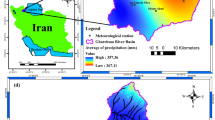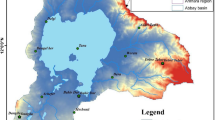Abstract
Drought basically consists of four main components: duration, severity, intensity, and frequency. The fact that these different components having impact on drought are related to each other brings some difficulties in drought research. These parameters are generally evaluated univariate in drought analyses, however, a “joint multivariate distribution” of these parameters is required for a realistic drought assessment. Joint multivariate evaluation of drought parameters can be determined with Copula functions. In this study, hydrological drought analysis is conducted for 16 streamflow gauging stations in the Tigris Basin, Turkey, with the Streamflow Drought Index (SDI). The drought duration and severity values are extracted using Run Theory, and the best fitted marginal distribution functions of each parameter are determined among 13 distribution functions. The joint probabilities of drought duration and severity are evaluated using six different copulas (Ali-Mikhail-Haq, Clayton, Frank, Galambos, Gumbel-Hougaard and Joe), and the best representing copula is found as Galambos according to Akaike Information Criterion (AIC) and Bayesian Information Criterion (BIC). Univariate return periods and bivariate return periods calculated with Galambos copula are compared and the results are evaluated spatially. It is seen that the difference between univariate return periods and bivariate return periods is in the range of 5–10% in most of the stations. As a result of the spatial analysis of the drought duration and severity in the Tigris basin with bivariate copula, it is seen that the central and western parts of the basin have a high risk.









Similar content being viewed by others
Data availability
The datasets used and/or analysed during the current study are available from the corresponding author on reasonable request.
References
Akaike H (1974) A new look at the statistical model identification. IEEE Trans Autom Control 19:716–723
Ali MM, Mikhail N, Haq MS (1978) A class of bivariate distributions including the bivariate logistic. J Multivar Anal 8:405–412
Altın TB, Sarış F, Altın BN (2019) Determination of drought intensity in Seyhan and Ceyhan River Basins, Turkey, by hydrological drought analysis. Theoret Appl Climatol 139:95–107. https://doi.org/10.1007/s00704-019-02957-y
Ayantobo OO, Li Y, Song SB, Javed T, Yao N (2018) Probabilistic modelling of drought events in China via 2-dimensional joint copula. J Hydrol 559:373–391. https://doi.org/10.1016/j.jhydrol.2018.02.022
Ayantobo OO, Li Y, Song SB (2019) Multivariate drought frequency analysis using four-variate symmetric and asymmetric archimedean copula functions. Water Resour Manag 33:103–127. https://doi.org/10.1007/s11269-018-2090-6
Azam M, Maeng S, Kim H, Murtazaev A (2018) Copula-based stochastic simulation for regional drought risk assessment in South Korea. Water. https://doi.org/10.3390/w10040359
Balistrocchi M, Orlandini S, Ranzi R, Bacchi B (2017) Copula-based modeling of flood control reservoirs. Water Resour Res 53:9883–9900. https://doi.org/10.1002/2017wr021345
Botai CM, Botai JO, Adeola AM, de Wit JP, Ncongwane KP, Zwane NN (2020) Drought risk analysis in the eastern cape province of South Africa: the copula lens. Water 12:1938. https://doi.org/10.3390/w12071938
Bozkurt D, Sen OL (2013) Climate change impacts in the Euphrates-Tigris Basin based on different model and scenario simulations. J Hydrol 480:149–161. https://doi.org/10.1016/j.jhydrol.2012.12.021
Clayton DG (1978) A model for association in bivariate life tables and its application in epidemiological studies of familial tendency in chronic disease incidence. Biometrika 65:141–151
da Rocha Júnior RL, dos Santos Silva FD, Costa RL, Gomes HB, Pinto DDC, Herdies DL (2020) Bivariate assessment of drought return periods and frequency in brazilian northeast using joint distribution by copula method. Geosciences 10:135
Dabanlı İ, Mishra AK, Şen Z (2017) Long-term spatio-temporal drought variability in Turkey. J Hydrol 552:779–792
De Michele C, Salvadori G (2003) A generalized Pareto intensity‐duration model of storm rainfall exploiting 2‐copulas. J Geophys Res Atmos 108(D2)
Dehghani M, Saghafian B, Zargar M (2019) Probabilistic hydrological drought index forecasting based on meteorological drought index using Archimedean copulas. Hydrol Res 50:1230–1250. https://doi.org/10.2166/nh.2019.051
DSI (2018) Strategic action plan 2019–2023. Directorate General for State Hydraulic Works (DSI), Ankara
Gumus V, Algin HM (2017) Meteorological and hydrological drought analysis of the Seyhan-Ceyhan River Basins, Turkey. Meteorol Appl 24:62–73. https://doi.org/10.1002/met.1605
Hangshing L, Dabral PP (2018) Multivariate frequency analysis of meteorological drought using copula. Water Resour Manag 32:1741–1758. https://doi.org/10.1007/s11269-018-1901-0
Huang SZ, Hou BB, Chang JX, Huang Q, Chen YT (2014) Copulas-based probabilistic characterization of the combination of dry and wet conditions in the Guanzhong Plain, China. J Hydrol 519:3204–3213. https://doi.org/10.1016/j.jhydrol.2014.10.039
Huard D, Evin G, Favre AC (2006) Bayesian copula selection. Comput Stat Data Anal 51:809–822. https://doi.org/10.1016/j.csda.2005.08.010
Huynh V-N, Kreinovich V, Sriboonchitta S (2014) Modeling dependence in econometrics. Springer
Jahangir MH, Yarahmadi Y (2020) Hydrological drought analyzing and monitoring by using Streamflow Drought Index (SDI) (case study: Lorestan, Iran). Arab J Geosci 13:1–12. https://doi.org/10.1007/s12517-020-5059-8
Kavianpour M, Seyedabadi M, Moazami S, Yamini OA (2020) Copula based spatial analysis of drought return period in Southwest of Iran. Period Polytech-Civ Eng 64:1051–1063. https://doi.org/10.3311/PPci.16301
Keskin ME, Özlem T, Taylan ED, Derya K (2011) Meteorological drought analysis using artificial neural networks. Sci Res Essays 6:4469–4477. https://doi.org/10.5897/sre10.1022
Kiafar H, Babazadeh H, Sedghi H, Saremi A (2020) Analyzing drought characteristics using copula-based genetic algorithm method. Arab J Geosci 13:1–13. https://doi.org/10.1007/s12517-020-05703-1
Li C, Singh VP, Mishra AK (2013a) A bivariate mixed distribution with a heavy-tailed component and its application to single-site daily rainfall simulation. Water Resour Res 49:767–789
Li TY, Guo SL, Chen L, Guo JL (2013b) Bivariate flood frequency analysis with historical information based on copula. J Hydrol Eng 18:1018–1030. https://doi.org/10.1061/(Asce)He.1943-5584.0000684
Luo Y, Dong ZCA, Liu YH, Zhong DY, Jiang FQ, Wang XK (2021) Safety design for water-carrying Lake flood control based on copula function: a case study of the Hongze Lake, China. J Hydrol 597:126188. https://doi.org/10.1016/j.jhydrol.2021.126188
McKee TB, Doesken NJ, Kleist J (1993) The relationship of drought frequency and duration to time scales. In: Proceedings of the 8th Conference on Applied Climatology, 1993. vol 22. Boston, pp 179–183
Mellak S, Souag-Gamane D (2020) Spatio-temporal analysis of maximum drought severity using Copulas in Northern Algeria. J Water Clim Change 11:68–84. https://doi.org/10.2166/wcc.2020.070
Mesbahzadeh T, Mirakbari M, Mohseni Saravi M, Soleimani Sardoo F, Miglietta MM (2020) Meteorological drought analysis using copula theory and drought indicators under climate change scenarios (RCP). Meteorolog Appl 27:e1856
MGM (2019) Meteorological disasters assessment. Turkish State Meteorological Service, Ankara
Mirabbasi R, Fakheri-Fard A, Dinpashoh Y (2012) Bivariate drought frequency analysis using the copula method. Theoret Appl Climatol 108:191–206. https://doi.org/10.1007/s00704-011-0524-7
Mishra AK, Singh VP (2010) A review of drought concepts. J Hydrol 391:204–216. https://doi.org/10.1016/j.jhydrol.2010.07.012
Mortuza MR, Moges E, Demissie Y, Li HY (2019) Historical and future drought in Bangladesh using copula-based bivariate regional frequency analysis. Theoret Appl Climatol 135:855–871. https://doi.org/10.1007/s00704-018-2407-7
Nabaei S, Sharafati A, Yaseen ZM, Shahid S (2019) Copula based assessment of meteorological drought characteristics: Regional investigation of Iran. Agric for Meteorol 276:107611. https://doi.org/10.1016/j.agrformet.2019.06.010
Nalbantis I (2008) Evaluation of a hydrological drought index European. Water 23:67–77
Nalbantis I, Tsakiris G (2009) Assessment of hydrological drought revisited. Water Resour Manag 23:881–897. https://doi.org/10.1007/s11269-008-9305-1
Nam WH, Hayes MJ, Svoboda MD, Tadesse T, Wilhite DA (2015) Drought hazard assessment in the context of climate change for South Korea. Agric Water Manag 160:106–117. https://doi.org/10.1016/j.agwat.2015.06.029
Özcan M, Gümüş V, Şimşek O, Şeker M (2019) Drought analysis of Bitlis River Baykan station with streamflow drought index (SDI) method. Acad Perspect Proc 2:1100–1106
Park S, Im J, Park S, Rhee J (2017) Drought monitoring using high resolution soil moisture through multi-sensor satellite data fusion over the Korean peninsula. Agric for Meteorol 237:257–269. https://doi.org/10.1016/j.agrformet.2017.02.022
Pathak AA, Dodamani BM (2021) Connection between Meteorological and groundwater drought with copula-based bivariate frequency analysis. J Hydrol Eng 26:05021015. https://doi.org/10.1061/(Asce)He.1943-5584.0002089
Pontes Filho JD, Souza Filho FdA, Martins ESPR, Studart TMdC (2020) Copula-based multivariate frequency analysis of the 2012–2018 drought in Northeast Brazil. Water 12:834
Sadegh M, Ragno E, AghaKouchak A (2017) Multivariate Copula Analysis Toolbox (MvCAT): describing dependence and underlying uncertainty using a Bayesian framework. Water Resour Res 53:5166–5183. https://doi.org/10.1002/2016wr020242
Sajeev A, Barma SD, Mahesha A, Shiau JT (2021) Bivariate drought characterization of two contrasting climatic regions in India using copula. J Irrig Drain Eng 147:05020005. https://doi.org/10.1061/(Asce)Ir.1943-4774.0001536
Schwarz G (1978) Estimating the dimension of a model. The Annals of Statistics, 6, 461–464.
Shiau JT (2006) Fitting drought duration and severity with two-dimensional copulas. Water Resour Manage 20:795–815. https://doi.org/10.1007/s11269-005-9008-9
Shiau JT, Feng S, Nadaraiah S (2007) Assessment of hydrological droughts for the Yellow River, China, using copulas. Hydrolog Process 21:2157–2163. https://doi.org/10.1002/hyp.6400
Sklar M (1959) Fonctions de repartition an dimensions et leurs marges. Publ Inst Stat Univ Paris 8:229–231
Tigkas D, Vangelis H, Tsakiris G (2012) Drought and climatic change impact on streamflow in small watersheds. Sci Total Environ 440:33–41. https://doi.org/10.1016/j.scitotenv.2012.08.035
Tonkaz T (2006) Spatio-temporal assessment of historical droughts using SPI with GIS in GAP Region, Turkey. Journal of Applied Sciences 6(12):2565–2571. https://dx.doi.org/10.3923/jas.2006.2565.2571
Tosunoglu F, Can I (2016) Application of copulas for regional bivariate frequency analysis of meteorological droughts in Turkey. Nat Hazards 82:1457–1477. https://doi.org/10.1007/s11069-016-2253-9
Tosunoglu F, Kisi O (2016) Joint modelling of annual maximum drought severity and corresponding duration. J Hydrol 543:406–422. https://doi.org/10.1016/j.jhydrol.2016.10.018
Tosunoğlu F, Onof C (2017) Joint modelling of drought characteristics derived from historical and synthetic rainfalls: application of generalized linear models and copulas. J Hydrol Reg Stud 14:167–181. https://doi.org/10.1016/j.ejrh.2017.11.001
Umran Komuscu A (1999) Using the SPI to analyze spatial and temporal patterns of drought in Turkey. Drought Netw News (1994–2001) 49:7–13
Van Loon AF (2015) Hydrological drought explained. Wiley Interdiscipl Rev Water 2:359–392
Vaziri H, Karami H, Mousavi SF, Hadiani M (2018) Analysis of hydrological drought characteristics using copula function approach. Paddy Water Environ 16:153–161. https://doi.org/10.1007/s10333-017-0626-7
Wee P, Shitan M (2013) Modelling rainfall duration and severity using copula. Sri Lankan J Appl Stat 14:13–26
Wu PY, You GJY, Chan MH (2020) Drought analysis framework based on copula and Poisson process with nonstationarity. J Hydrol 588:125022. https://doi.org/10.1016/j.jhydrol.2020.125022
Yerdelen C, Abdelkader M, Eris E (2021) Assessment of drought in SPI series using continuous wavelet analysis for Gediz Basin, Turkey. Atmos Res 260:105687. https://doi.org/10.1016/j.atmosres.2021.105687
Yevjevich VM (1967) Objective approach to definitions and investigations of continental hydrologic droughts. An. Colorado State University. Libraries
Yüceerim G, Yılmaz G, Etöz M, Acar CO (2019) Kocadere Havzasında Standartlaştırılmış Yağış İndeksi İle Farklı Zaman Ölçeğinde Kuraklık Analizi Toprak Su Dergisi, pp 70–76
Zhang L, Singh VP (2007) Gumbel-Hougaard copula for trivariate rainfall frequency analysis. J Hydrol Eng 12:409–419. https://doi.org/10.1061/(Asce)1084-0699(2007)12:4(409)
Zhang Q, Xiao MZ, Singh VP (2015) Uncertainty evaluation of copula analysis of hydrological droughts in the East River basin, China. Glob Planet Change 129:1–9. https://doi.org/10.1016/j.gloplacha.2015.03.001
Zhao PP, Lu HS, Fu GB, Zhu YH, Su JB, Wang JQ (2017) Uncertainty of hydrological drought characteristics with copula functions and probability distributions: a case study of Weihe river, China. Water 9:334. https://doi.org/10.3390/w9050334
Acknowledgements
We greatly acknowledge the General Directorate of State Hydraulic Works in Turkey for providing the data used in this study.
Author information
Authors and Affiliations
Contributions
YA: performing analysis, interpreting results, and writing the manuscript; VG: conceptualisation, coding, writing the manuscript.
Corresponding author
Ethics declarations
Conflict of interest
The authors declare no competing interests.
Ethics approval
Not applicable.
Consent to participate
Not applicable.
Consent for publication
All the co-authors are familiar and agree with the content of this paper.
Additional information
Responsible Editor: Clemens Simmer.
Publisher's Note
Springer Nature remains neutral with regard to jurisdictional claims in published maps and institutional affiliations.
Rights and permissions
Springer Nature or its licensor holds exclusive rights to this article under a publishing agreement with the author(s) or other rightsholder(s); author self-archiving of the accepted manuscript version of this article is solely governed by the terms of such publishing agreement and applicable law.
About this article
Cite this article
Avsaroglu, Y., Gumus, V. Assessment of hydrological drought return periods with bivariate copulas in the Tigris river basin, Turkey. Meteorol Atmos Phys 134, 95 (2022). https://doi.org/10.1007/s00703-022-00933-2
Received:
Accepted:
Published:
DOI: https://doi.org/10.1007/s00703-022-00933-2




